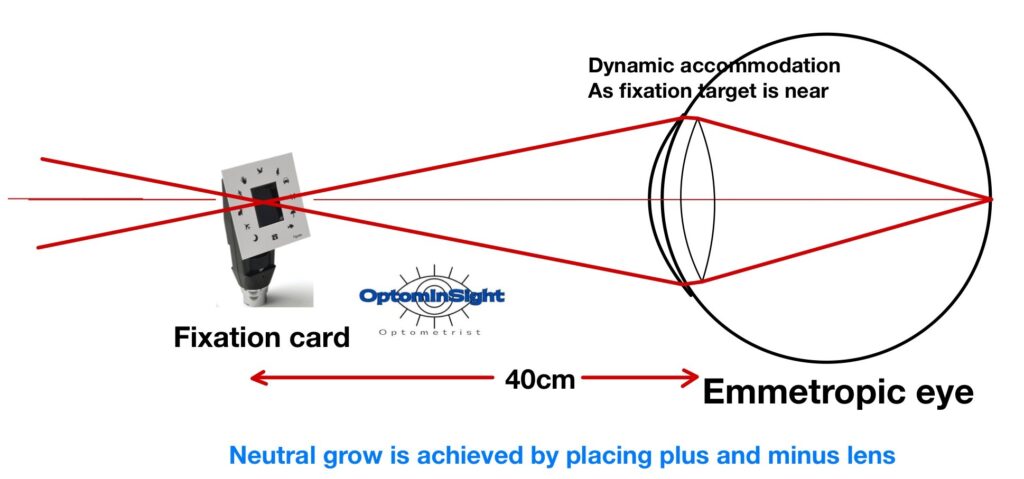MEM is a dynamic retinoscopy technique involves the use of a retinoscope with a series of cards attached to its head using magnets, such as the Welch Allyn retinoscope. These cards have a central aperture that helps the examiner align their viewing axis with the subject’s visual axis. The cards contain targets, such as printed words or pictures, in various sizes ranging from 6/120 to 6/9.
The test is performed in a normal room illumination, and the examiner positions themselves 40 cm away from the patient, maintaining the same eye level. The patient is asked to wear their appropriate spectacle correction, or if subjective refraction is being conducted, the trial frame with patients’ appropriate correction is used. During the test, the examiner observes the motion in the horizontal meridian (keeping the retinoscopy streak vertical) while the patient reads the words out loud.
To neutralize the reflex observed during retinoscopy, the examiner uses plus lenses for movement towards and minus lenses for movement against. These additional lenses are applied for very short durations (less than 1-2 seconds) to minimize the impact on accommodation as plus lenses relax accommodation, while the minus lenses activate it. The test is only performed in one meridian because it is done after subjective refraction, where the cylindrical power of the eye is fully corrected. In other words, the other meridian will also neutralize with the same lens. This approach ensures a quick procedure that minimizes changes in accommodation due to the additional lenses.

The examiner continues to try different lenses until neutrality is achieved, and the power of the additional lens is noted.
The interpretation of the Monocular estimation method results is as follows:
If the additional lens power is plus, it indicates a lag of accommodation. This means that the patient exerts less accommodation to see the target located 40 cm away, and the examiner requires additional plus power to achieve a neutral glow in binocular viewing.
On the other hand, if the additional lens power is minus, it indicates a lead of accommodation. This means that the patient exerts more accommodation to see the target, and the examiner needs to use a minus lens to diverge the rays and achieve a neutral glow.
- Normal values for the additional lens power range from +0.25 DS to +0.75 D.
- High lag of accommodation is observed in conditions such as near esophoria, convergence excess, accommodation insufficiency, under corrected hyperopes or overcorrected myopes, and presbyopia.
- On the other hand, lead of accommodation is seen in near exophoria, convergence insufficiency, accommodative excess, spasm of accommodation, and under corrected myopes or overcorrected hyperopes.
Lecturer (Nethradhama School of Optometry)
Moptom
